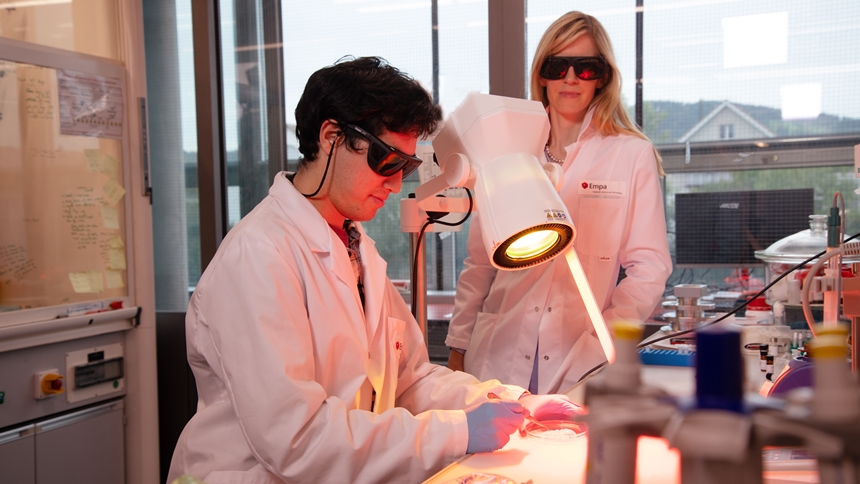Tokyo (SCCIJ) – Academic scientists and start-up researchers have come up with new methods to close and heal wounds. One process uses lasers to solder wounds instead of using a needle and thread. Other methods are using “good” bacteria and reprogrammed cells.

Soldering wounds with a nanoparticle paste and light: Oscar Cipolato and Inge Herrmann in Empa's Particles-Biology Interactions laboratory in St. Gallen (Empa).
Smart temperature control
Researchers of the Swiss Federal Laboratories for Materials Science and Technology (Empa) and the Swiss Federal Institute of Technology in Zurich (ETHZ) have found an innovative way to close open wounds. So far, temperature control of the thermal reaction has been very difficult to achieve.
However, a team from the Particles Biology Interactions laboratory at Empa in St. Gallen and the Nanoparticle Systems Engineering Laboratory at ETHZ developed a bonding agent with metallic and ceramic nanoparticles and used nanothermometry to control the temperature. This makes the method particularly suitable for use in minimally invasive surgery,
The Swiss scientists put two types of nanoparticles in the bonding protein-gelatin paste. While the paste is irradiated by laser, titanium nitride nanoparticles convert the light into heat. Special bismuth vanadate particles in the paste, on the other hand, act as tiny fluorescent nano-thermometers, allowing extremely precise temperature regulation in real-time.
Good bacteria to combat pathogens
Separately, researchers of Empa and the Massachusetts Institute of Technology together developed a special wound dressing that is particularly effective in chronic wounds. They use bacteria, which they call ‘good bacteria’, to combat other pathogens. Their weapon is probiotic lactobacilli.
They already play a positive role in healthy intestinal flora in humans and are well tolerated by the body. They also have an important property: they produce lactic acid and thus create an acidic environment. This is why they can change the alkaline pH value in chronic wounds. In the laboratory, it has also been shown that this lactic acid production attracts cells that contribute to wound healing.
In another research project, scientists succeeded in using reprogrammed cells to heal wounds in old people more quickly. This method developed by researchers from the Paul Scherrer Institute (PSI) and ETH Zurich should help burn victims in the future.
The researchers reprogrammed aged cells from real skin and inserted them into a model of old, injured skin tissue in the laboratory. According to the research institute, this significantly accelerated wound healing. The reason: similar to a reformatted hard drive, the reprogramming of cells also deletes functional errors that the old cells had accumulated during aging. This makes them, like a newly installed computer, faster when they run newly installed programs.
Text: SCCIJ with material from Federal Council and Swiss.tech





























